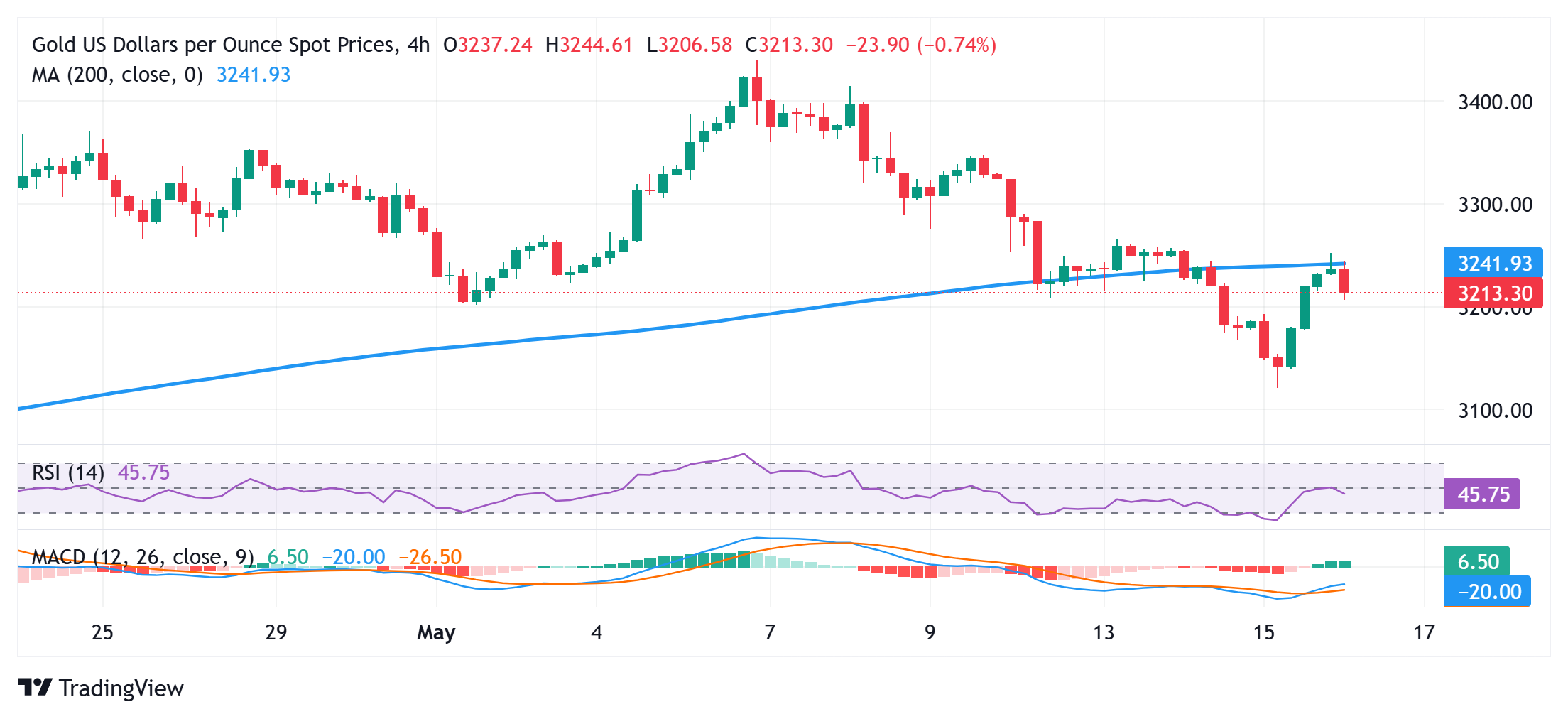- Gold price meets with a fresh selling pressure and erodes a part of Thursday’s solid recovery gains.
- The US-China trade deal optimism acts as a headwind for the safe-haven precious metal.
- Fed rate cut bets keep the USD depressed and should limit losses amid geopolitical risks.
Gold price (XAU/USD) struggles to capitalize on the previous day’s strong recovery move from the $3,120 region, or the lowest level since April 10, and attracts some sellers during the Asian session on Friday. The US-China trade truce for 90 days has eased some of the pressure on global markets and is seen as a key factor acting as a headwind for the safe-haven bullion. However, persistent geopolitical risks and a softer US Dollar (USD) might hold back traders from placing aggressive bearish bets around the commodity amid bets for more interest rate cuts by the Federal Reserve (Fed).
The incoming US macro data pointed to signs of inflationary pressures and backed the case for further policy easing by the US central bank. This leads to a further decline in the US Treasury bond yields, keeping the USD bulls on the defensive and should act as a tailwind for the non-yielding Gold price. Hence, it will be prudent to wait for strong follow-through selling before positioning for the resumption of the precious metal’s pullback from the all-time peak touched in April. Nevertheless, the XAU/USD pair remains on track to register weekly losses amid the trade optimism.
Daily Digest Market Movers: Gold price bulls refrain from placing aggressive bets amid trade optimism
- The US and China agreed to significantly lower tariffs and initiated a 90-day pause to finalize a broader deal, marking a de-escalation of a disruptive standoff between the world’s two largest economies. Moreover, US President Trump pointed to ongoing negotiations with India, Japan, and South Korea.
- Negotiators from Russia and Ukraine, as well as a delegation from the US, are currently in Istanbul, Turkey, for the first direct peace talks in three years. However, Russian President Vladimir Putin’s absence has already dashed hopes for any breakthrough toward ending the prolonged war.
- Meanwhile, Israel’s military intensifies its carnage across the Gaza Strip since dawn on Thursday, and the relentless assault, so far, has killed at least 143 Palestinians. This keeps geopolitical risks in play, which, along with the lack of any US Dollar buying interest, could support the safe-haven Gold price.
- A duo of weaker economic reports released from the US on Thursday reaffirmed market bets for more interest rate cuts by the Federal Reserve this year. This, in turn, dragged the US Treasury bond yields sharply lower and undermined the buck, lending some support to the non-yielding yellow metal.
- The US Producer Price Index for final demand fell 0.5% in April, marking the first monthly decline since 2023. This comes on top of softer US Consumer Price Index (CPI) on Tuesday, which rose at the lowest annual rate since February 2021, and further pointed to signs of easing inflationary pressures.
- Separately, the US Department of Commerce reported that Retail Sales rose 0.1% in April compared to the previous month’s upwardly revised growth of 1.7%. This increases the likelihood that the US economy will experience several quarters of sluggish growth and reaffirms dovish Fed expectations.
Gold price needs to surpass the $3,252-3,255 immediate barrier for bulls to seize near-term control

From a technical perspective, the goodish recovery move from over a one-month low falters near the 200-period Simple Moving Average (SMA) on the 4-hour chart, around the $3,252-3,255 zone, amid still negative oscillators on the daily chart. This makes it prudent to wait for strong follow-through buying before confirming that the XAU/USD pair’s downfall witnessed over the past week or so has run its course and placing fresh bullish bets.
In the meantime, weakness back below the $3,200 mark might now find some support near the $3,178-3,177 region. Some follow-through selling could make the Gold price vulnerable to accelerating the slide back towards the overnight swing low, around the $3,120 area. The downward trajectory could extend further towards the $3,100 mark en route to the next relevant support near the $3,060 region.
On the flip side, the $3,252-3,255 area might continue to act as an immediate hurdle. A sustained strength beyond might trigger a fresh bout of short-covering rally and allow the Gold price to reclaim the $3,300 mark. The latter should act as a pivotal point, which, if cleared decisively, could negate any near-term negative bias and shift the bias in favor of bullish traders, paving the way for further gains.
US-China Trade War FAQs
Generally speaking, a trade war is an economic conflict between two or more countries due to extreme protectionism on one end. It implies the creation of trade barriers, such as tariffs, which result in counter-barriers, escalating import costs, and hence the cost of living.
An economic conflict between the United States (US) and China began early in 2018, when President Donald Trump set trade barriers on China, claiming unfair commercial practices and intellectual property theft from the Asian giant. China took retaliatory action, imposing tariffs on multiple US goods, such as automobiles and soybeans. Tensions escalated until the two countries signed the US-China Phase One trade deal in January 2020. The agreement required structural reforms and other changes to China’s economic and trade regime and pretended to restore stability and trust between the two nations. However, the Coronavirus pandemic took the focus out of the conflict. Yet, it is worth mentioning that President Joe Biden, who took office after Trump, kept tariffs in place and even added some additional levies.
The return of Donald Trump to the White House as the 47th US President has sparked a fresh wave of tensions between the two countries. During the 2024 election campaign, Trump pledged to impose 60% tariffs on China once he returned to office, which he did on January 20, 2025. With Trump back, the US-China trade war is meant to resume where it was left, with tit-for-tat policies affecting the global economic landscape amid disruptions in global supply chains, resulting in a reduction in spending, particularly investment, and directly feeding into the Consumer Price Index inflation.

